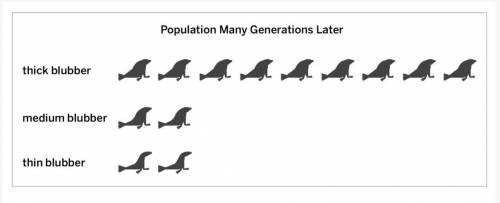
Social Studies, 20.04.2021 19:10 Will1119
Harbor seals live in northern oceans and have a layer of blubber (fat) that keeps them warm. Seals can have blubber of different thicknesses.
Seals with thicker blubber are more likely to stay warm and survive in cold ocean waters. But, in warm ocean waters, thicker blubber can make the seals overheat and die.
(First picture)
Harbor seals live in northern oceans and have a layer of blubber (fat) that keeps them warm. Seals can have blubber of different thicknesses.
Seals with thicker blubber are more likely to stay warm and survive in cold ocean waters. But, in warm ocean waters, thicker blubber can make the seals overheat and die.
Diagram titled Population Before containing 2 rows of seal icons. The first row is labeled Medium Blubber and contains 2 seal icons. The second row is labeled Thin Blubber and contains 9 seal icons.
The diagram above shows a population of seals that lived in an area of ocean. Scientists had previously only seen seals with medium or thin blubber in this area of ocean; they had never seen seals with thick blubber.
The diagram below shows how the population changed after many generations.
(second picture)
Edin says the change in the seal population was caused by a change in the environment.
Vada says the change was caused by a mutation.
Miko thinks both Edin and Vada are correct.
Who do you think is right? Explain what happened to the seals over many generations.



Answers: 1


Another question on Social Studies

Social Studies, 22.06.2019 11:00
The renting agent says i have to rent for at least one year. but i’m not sure how many months i’ll be in town.
Answers: 1

Social Studies, 23.06.2019 05:00
Which of the following statements best describes relations between india and pakistan? a. the countries have had peaceful relations since the partition of india. b. the countries have an ongoing trade dispute with bangladesh. c. the countries have had conflicts over the region of kashmir. d. the countries have agreed not to develop nuclear weapons.
Answers: 1

Social Studies, 23.06.2019 15:00
Recall that areas with high net primary productivity not only produce high levels of biomass rapidly, they also take up large amounts of co2 and give off large amounts of oxygen. what is the likely result of the increasing amounts of sediments and fertilizers in the major rivers emptying into oceans and affecting algal beds, reefs, swamps, and estuaries? a fisheries will improve as the extra nutrients feed shellfish and fish. b eutrophication, followed by hypoxia, is a likely result, ultimately leading to less co2 uptake and more oxygen released. c productivity in these areas will increase permanently, leading to more co2 uptake and more oxygen released. d eutrophication, followed by hypoxia, is a likely result, ultimately leading to more co2 uptake and more oxygen released. e eutrophication, followed by hypoxia, is a likely result, ultimately leading to less co2 uptake and less oxygen released.
Answers: 1

Social Studies, 23.06.2019 15:50
Pre-tesi active how does the contractile vacuole in a single-celled organism function to maintain homeostasis?
Answers: 2
You know the right answer?
Harbor seals live in northern oceans and have a layer of blubber (fat) that keeps them warm. Seals c...
Questions



Mathematics, 01.01.2020 04:31


Social Studies, 01.01.2020 04:31

Mathematics, 01.01.2020 04:31




Mathematics, 01.01.2020 04:31

Biology, 01.01.2020 04:31






Mathematics, 01.01.2020 04:31

Mathematics, 01.01.2020 04:31

Mathematics, 01.01.2020 04:31




